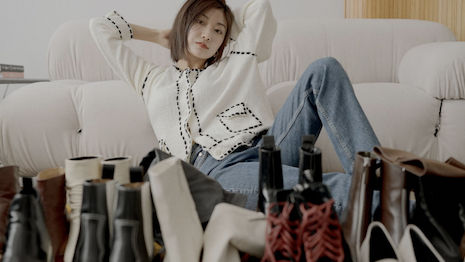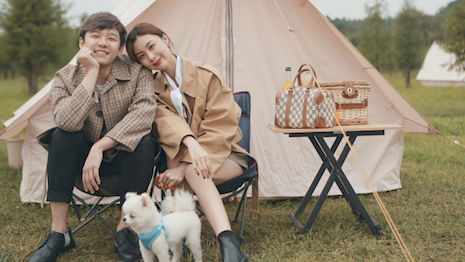As China’s Gen Z consumers have become increasingly sophisticated in their consumption patterns, their personal styles continue to evolve.
Due to an increased use of video as a medium for expressing fashion preferences, Chinese social platform Bilibili has become a significant predictor for China’s fashion trends as well as brands’ go-to platform for discovering these trends. In partnership with Alibaba’s Tmall and online marketing tech platform Alimama, Bilibili has released its findings on the latest Chinese consumer fashion trends today.
What’s trending
The “2021 Spring and Summer Season Fashion Report” suggests that Gen Z remains the main driving force behind China’s fashion consumption growth.
With an average capital expenditure of 51,260 RMB, or $7,871 at current exchange rate, Gen Z fashion consumption in China accounted for 30 percent of the overall fashion market in 2020, with a year-over-year growth rate of 106 percent.
In 2019, the population of Gen Z in China exceeded 226 million, accounting for 16 percent of the total population, according to the report. With 86 percent of Bilibili’s 202 million monthly active users under the age of 35, one out of every two young people in China is a Bilibili user.
Bilibili is the top platform for China’s Gen Z to pursue fashion-related content, according to the report.
In 2020, the number of video views generated from fashion content on Bilibili grew by 130 percent year-over-year, while the number of video views generated from professional fashion shows increased by 140 percent year-over-year.
Based on research collected from Bilibili content, the report identifies three major fashion trends and key cultural preferences among China’s Gen Z.
 “New classy look” is China’s latest fashion buzzword. Image credit: Bilibili
“New classy look” is China’s latest fashion buzzword. Image credit: Bilibili
The number one fashion trend on Bilibili is the “contrast look,” a blend of retro, futuristic or surreal elements such as cyberpunk with everyday, mainstream style in China. Video views of “contrast look” content more than doubled in 2020.
The second trend is the “new classy look,” with durable, versatile and minimalist products. According to Bilibili and Alibaba, China’s Gen Z’s heightened sense of value for money has led to a shift in their expectations of quality.
The number of “new classy look” videos on Bilibili increased by 240 percent in 2020.
Lastly, the third major trend is expanding fashion and style into all lifestyle scenarios, such as at home, in the gym or camping.
The COVID-19 pandemic shifted young consumers’ understanding of fashion from daily wear to a comprehensive lifestyle look. Stylish, comfortable and durable activewear and sportier lifestyles are trending immensely among China’s Gen Z.
In 2020, activewear-related content on Bilibili increased by 80 percent, while general fitness content increased 180 percent.
Additionally, the market for smart home devices, stylish home decor and loungewear accelerated dramatically as time spent at home increased. In 2020, video views of smart home-related content on Bilibili increased by 120 percent.
As lockdowns limited social gatherings and outdoor engagement, camping has become a new setting in which Gen Z seeks to showcase personal style. Views of camping-related content increased by 160 percent.
This has led to a surge in upscale camping, or “glamping,” which offers the camping experience with high-end amenities often associated with hotels or resorts.
 Camping has become a new setting to showcase one’s sense of style in China. Image credit: Bilibili
Camping has become a new setting to showcase one’s sense of style in China. Image credit: Bilibili
China’s Gen Z cultural preferences include: street culture, such as skateboarding, graffiti, tattoos and hip hop; gaming culture; ACG culture, such as animation, cosplay, Lolita fashion and virtual idols; pop culture, including electronic music, street dance, clubbing and music festivals; internet culture, such as auto-tune remixes, memes, emojis and stickers, celebrity news and short-form video content; art; and city lifestyles.
Ahead of the trends
Historically, consumers would look to fashion houses for inspiration as brands were the ones setting the trends. Now, it could be argued that brands are looking to keep up with the dynamic trends set by consumers on digital platforms such as Bilibili and TikTok.
Aligned with the growing “outdoorsy” trend among China’s Gen Z consumers, Italian fashion label Gucci released a nature-inspired campaign showcasing its collaboration with outdoor recreation brand The North Face. Based on the notion that travel leads to self-discovery, the collaboration aims to empower people in their quest to celebrate and express their own characters and personalities.
Through a series of still images and film, as well as short form content created for TikTok, the campaign follows a group of Gucci-clad hikers through a trip to the great outdoors. The forests and mountain peaks of the region provide a scenic backdrop to the imagery (see story).
Keeping up with the gaming trend, French fashion label Balenciaga and Streamline Media Group teamed up to bridge the worlds of gaming and fashion, resulting in an interactive fashion-gaming experience, Afterworld: The Age of Tomorrow.
While Balenciaga was not the first to incorporate interactive gaming into its brand, the launch marked the first time an international luxury fashion brand debuted a wholly digital in-game experience (see story).
{"ct":"CWK3LWRTV1XV1fFUs0nNfncF\/n9c\/PmwIpisDk6u5XczkHSmdkqo30DAKBl1U9jCVko3HOdSLHQo2MIOcUqZunVvyUGrdNteaOr+ysjQtht2jqdSJjNWIc53TmKI0qXxLpC7g80x0a\/mgOqpZEoPXDY4faI7UoPbTPQk37VQkyycZTKXXp3hR2A5fPINpU1zVBVTJWe7Afz7\/FTZu04sTvW1ZduwiVHc\/C\/YkwyR3CqSHCYS6oKrEccI8INml1bW8rAEguGY+egBGi5rHwDxld\/LqpXY6qdtF2L5iVd0ZDUSkCnqoTapnaGjKlsY0nnVo9QfEHrYOOF8jfYgTaWqwZvge5l6Sm5\/IlDNAS3PVdTxBS1pxSYGHhYPFiB0RpAFJI5GQQstRQxUeX\/4oW1bzXrmj+xe4ZXFUWuwmqxwhoDz2LR2unUQj22+sqY1Fu4D3jp45HYNeOHb9fPy5ycRnHebzgOom1\/l+gOgmZVp50K6zTuqxjOgP3KrZN3rQ4qIujbElt3D8KErjSmdAJSksiGjblHdefD5otjxbwbanCA9\/z3LwZUf2PO+7cMcY\/so41GJSyQM+i4xy3QiMHzV6QfDbq9dOlNsU\/Ua0wUfMOqWcfGbIpJ0gTZSkdnEBuUMIXZMQfW8exvV\/qs\/1RVuYEKLjiWvIHdVm\/Bz3Q6R0f23eBtmlhoM0HdrEmRhvxTu97FY0oF6xwpNIQimDDMxCs24Yq1oPxM48uJNlp1AB1yuTj9evy8U\/I6N2dCQusInnfly\/WU2HuRTZseK8UIvLDx0jEQ7SfgE5f4aOSqWZW0fH0QWD2Fj4vxeemnhGSvObzKQUCmQNbK2bwEpERuCL3UOp3LaFJzPFk4QbABcUz6zKtZERJ12wRwFF\/TyTuBapIpl34FidFezDRs4OnxPFb+wK9jQe6\/Zu+HsnewF07mj8xLn6dkFSqp+dvTbmLdvEKQB5aWjcpyeBo8qeHoUFnvPcpuk96Q5xwglAMRtixHNELZVrmGaXcfHGiqJdezzHXD0xm81PmEmef+IsX8nU8lDtFW2wzh3rnZJubETcYLPK2bbChKrRvAoUnVcUbHaTFmAnBEH6LrE4bUE5Rv+OCY2Wy74CvyE19\/UxG3zFo5sjhwKVMibzMkZiYgP5iNJpz87I7StEviMEK5Ltc68ifYIxNdrSda2n43Ywca1c0J4HgK7v9alnWXXwqI+UZUhWU0RAoR2ckw3x2LXFj00dvrJu7xqOgRIox8UqRPPauVOXwBN6gEKI\/cGDxBs2d4m9rMWIBwGIlbYW7UARzqRxejpCdNTS0v5CKe5Nx0wtC68qdajKRF6GYcylF2jn6hPcEVnUczbV2TPFXFGA2Bw5F+wHGkJRL5yg08F4utW9cGrmekHnQ\/GCUnZ7MKQ9+rJDrO0G9WlyAwZDjPovQtT2mejrIkXRs5neqf4fshpI3mQLGXPXEAcJK\/Z\/T+vLsq6mni9yS55bQ7zgxUnQ2+ls06akmCRenC+yEZdS2DZ7d0HA0hhsMke+NZLS39YkAAIUh3Mn2LRb1CaVXyfetrjYdBDUbCrFBPy52vx2yG2IdyWj2q9KNk\/Omi62DhhBcZ2E\/58jqq6V1Jq\/C9OBVlWJBrhWfyR5Hi65rFxN\/5IHSXNG2pb6cJNqEYAol1iv5eHo\/FFPg4MrL+mhiR9kF+Z7DahM46OGHLhlQyWFnqjhhwAz\/OFJlndaUp5rO1YAK+qkL89k9y1oR1IUSspy54xbE9XaR0jeFhq+9A8c2Ws3twSOLLuRwsaEcAqDHMGznjlxxHHp\/2DMY6UUB6MjTmFKzeRJtoQjt\/Ah8cOs0xQczLhqFVuM6F47NAoQ7u+eGPwdJUTTowvsjD6vqnkasoivgo8kXwUAzTN6L7EEj2wUamhaxMLQWnfaA17QUSCrZSfdte9a0wTCiB+19YV8T70fsorWLXp\/df09hFvidErPN3L0Qrkca8YTmrvB0zpB36XH2M07LM+G88jEqAmZWEEqXQb8m8sjSHJ\/d\/VMwQiEXwD1lwsxewKcEj8N93ZNNb3zX5xmOahb9P\/YJBg89fjDYawyVdAzAHlhPVwMn5EBeSeqTkNmzdCTZVr26FMsmCiwEkdu3mZiKusVClzr74DXAkXYIHaxJA20rBiJxdVMYoK\/scKOxF+YmNramYaAFVHU8fJ3VgIDc6nhCYVtD5I+T30HW+L+sUMiluGSq2H6n2Z5arnpn\/a6DqKo+5ymzAcbzNFH2V1MPoCOpNbBuvTJY1C\/cGvRfEyhkj5qLsgzLui0h1hR+jy5Bfyo3a6\/fsESORcfJqltZMRY0ti4pRvLZWD\/c180fsk8B+\/vggLUeLIKIVpH3PnXr36W5lIJpYkguFlFvymR3eWoWvLz2svNdYCtLUbJkZBu7TSRKr2N8Pyxw41gf1nPhQxF692fGKZI+a4WYNbyJwio8p50KMILZ5Ti2IIBJsPF6p3WO4yBAmF4C2CJItXrMTLjkKYuk2reNGbETAWEBxbmV5KCAncAOSYlmDHc2psw7PusPxC1l4Rwrd6nu1uk+ZmeEOff7krKe9jUHT4IDnpBEs+m9EPtRilSQ6hHI+c\/mgbmq8OIig2zJeKLiO7+XOvhJ+Ag+DXoX6mgmvKflGBT1gLy\/zpyxpz4lrSwQZwPEAokcPjrD+KHy6AC+gltdWuuYluHolWmsUQToLs+HdDgXWppdVlVDmiWiKgoHPGNh6qkX4FxwOaPNno3M0ZYDfVBq72Vh+BViN4FV45arKbkOub7CGoIQrjZw7GXdsk7j0S6ScC3s06r1scOFu1cvEnrZlF4\/\/9Q3hqcp6x0n4xWWmKmoMNjQyFIHUl\/pdOmCf6wxq7OGopnSQRKHGd5esenPcUgPDUPXMZNflHltqhqnXPL97umEc02adx3AI\/P4gagsL2iNXIHCH3QFJKHG3wPBIKT1118KgtTMN\/yZtapve3ngL1vygif36U4RRlE9He54Tbh4+xzxhLWY8dafP4Y4MO6Pp\/kXUCExiGdjiaR4Yj0GNraeD0\/NyxsVmuptQMp603YJA1kkwAb+3zwao9q8ICR1YCQ5el0ex8lxfXbaTgqtRv8stBlDsL4R0yV5HkNtJmFaptEx0AtSuEOserbyw6vQ2EsgcblvEIRRMz2LnNc9kQAJNUf6QDIP28U25vYWnfCl\/a5ssJqZg2vcgOnrvUVJz4Sypd1laGCnXzPKULc0\/v852AYFtXiSXFEQ27u56tlVDHbgJLyN52oPXy3tuzctwkuF8beiv5X\/welZSnnKKL5xJ0jwjlmqf13gjc5L2553EhO7L8SOVJGeNxn6kmilMFlu58iBkKuGKD+XSqL6eIvUPYGHOE8pcgV4TMSaH1pwPNxNJKjrFzyGs\/HLiLBpHoWnNhytL3NomgvKsr6wrXGZDne+dJKvcXjDPf4y8MSvKJNMh4+yvSvfm1QV5ssq6po3Zg0ZHrI8COTmm9bMlfzZMMU4iJXnoklVXd131VpSDmaJI5BDlUXGCTNthmiNWfsCu6Mobozt8Xngr6oznsN8CBfjJV0tOmqGy5EhxQOyhYD1pprax14MtL2Ge2JAfR8JayjSsC\/mlSt2pBwsnlEdlY5UZEaor7vYEcB3vJOUkWRPGBTOdVbXuc+WKQVDbJZvNwwjNhlgAf4Ja460Hf+Opramd\/aTkPRnzmEWVg7zRk7Lov+Doh9hiCN6GkwmLdEc\/5h73o\/9m3DHwFmLpvgifFuSw\/FzkbpQLcGyRk9Ewey\/l7iIkdefYpv3vVGgAonEey+3a5l0qCsM\/nSM4kY2PEFMphajxR+IgOqu7uYuy2cYt3cgJf0rtT1N0f7Wy3pwEN1l9N594lJFGgTAVgF2SqhyaNEkhG4ymKshrT8isfxS1JQ\/Uly+2YlpT\/CEUXecGLMmAJGK8dlraSdSqpQ8cd2ItId+I3N79dGWKzDSGuNKQxEsfHKPAVgsg6SjHAAyESlimhohjwXODSPdlLwllQ5axBBqsiBqhcOBHlwW61U+U6dx6utNOFlfFqE1OTv+\/yhQZ8tvLEPpYzzlb\/nCruyevy3vfzDdwUEAV0eecfdMB02icucXuG\/mti4aYMPrNZs1PDcSXG2Kof0K0WP6JMWDuqfywi18grnGPXf3o\/vKrEgX5pMbaNtxw2tKI2\/QgJ1TmYypyrtIrXgr5zqG3LBMPoEbI4aoQq8DEpmoMYzVlqn0dNrDNHrSgGJ7Zb0zkIb2iZ7LwaSr+AE7jPXIl2bSgyeRfRlhRd4MAi9B3BGP2rnFU70EiBzyfDP5mELuy2N\/9S3XIak38T9He\/hwSoIiCf4iOHeuVnWsB+WrtLZP\/Q\/9ag8JWwBOojbZ5KbzzlQAXpcEumHNcWUrRZOcsa\/8GrImOo\/Z3TMhAQQQmfcuIR3YYZhfC84jN1NmJF3IDok9uPjRLXU2xf3bSBlO9+HvjkH+Aa2ZSQJQ+vbj1g1ll1i8LGT\/TBv3zt9CP3LIa0SF2RNZjjV61uiJfWDZkjQtbL4bQui4+R4mj+cT7p9nX0gXRtLPQYMDfGx3BDg07Aqr6wVQ2\/h2L35RfISehrKoYcegKq18WewAwCXL5AtF1ZIaOO+NSYH86F92bvQqDLkfWsowuP4kFCWg7DIjv0Xszx8BONmTLZVQZua+D96gQuvFCL2H\/pgaojqFOH3aRdDdcGe2M3VFu\/QwKP3tyezhbX8xHeChJqskn0EvhLGOchCwR41n+4+ylTGxf0J3J0wQyhVuggv7bFoNZQCno6z7RAhdEIcY6OnbkhSuOS8adkUdFSgxkHjHaoS4YFLfpaaAXT\/o9NGlpVBDqfVIVSRSLMsqJdg3QMFwImrA6FZsqKEjnYxdc\/U2hvcNK2bQzrcN7G0IMCFYZOenMEeEU8kZ5lWKocXqvsnSPtwmLOUGb7UM49tp6qAsQfXplJ5HZ4c1gT+9hrHUwHIqYNSiGpBrrRC\/DdMHN4B1d9MaQSmSZrEI9CCBOgaqipT9kCHnQcwch4AcZzMe8o9dINJ32pegksYsJVN8OoOk25JykzuioNIeSmoqI7jTeHdVnuE9ESlVIKzz1JHnyKrr+h47LyPHlDghXJIFhioxgIBW4ai\/U49PSeIJuU2LswZDjolT+8ZbnazQ6ikeBN89AymzY4TS7nuHmlQtBm3GVOgf+9TEGOhcmXo+eNNkWpBuWUmvQxYee7Dy7hOvRQYo2itRbAe5mXwdhlEKGs1+wuMEruVfm56d33r\/a92ugdR9MbnatKxsCrpP+ivL3spAQ4VMnxshe3DsnasGrmq6\/5+8nDH+\/v+mfQddm\/rN0koAClwop+jwX45dMVRuaqE+xs0ijfDgEW1RKXinmnJ8KnvvMi375ZpBYK+ZPz7cwwFTpW7TJeYliEIHP\/033eoQhcf2qaYchC9K\/7jQaypm4sGyNrycry51Ywm3vJLoR\/bnIi3a3I1U\/c+eml6nFpcDYk\/W7rc6t6CL8IcakkSG4uC4w2C398fQKwqAYEaT4BnOqg9xncHA4doh32kknD\/RGSIveXkMOVQgwxcc2GB7JxJXyKUTjt0ZGIWMLC7otVwOb4NyNvYOxWv0NjY7yDR6\/5HXaL3ww+VNi8OYbjvz9YfPXKu+BzlBk08r1BCSKskYXGLwFFDnnUj3V0PryyxSddjdc7XYkBuv4CIByF\/1JuEyMcQFBQz\/hUs3JCgmx3K\/tMGxpgBd8uj3qHBO6FIpAwuMQBxy6fMv7oZtLoZtlY+TnxbE4Ed604k95c1L3efnQBzmrHfNrWERePIw6jEbFb7tC870XzoMnveBYxGKcPH1jc2TML7ajNqkI\/oKsVPGfawFYck7wgDfBXJUBlVwtNjkCgb2TgB1AMlVgpc94L+7H9FxS1+36O1Sg4U2t6+up9pdwYY7AQEaBCOIDFOh0AMRpdQ6ymixz3WqNsLXsUvSuwG0O5T3BpqDeQ63TmkbAY1fqOVtHjcrz7h1GFMozaOLPF5GlGqHM5wl7NAEQSknlhhUIm7sCqru4Y334oNxZoD9fFnFfBB3gysnkabWrlpHkZimaaXMhqEZFxyq1ItxHZvDUaecrN6hdDZ7U9XJfLcOTirFH4d9s6N4S8qSUcO3J+P3JdHvjpM3IXo308p9K26BqMtZml8+2\/6+3XVdYbFyEQb3EKpoXMjwlQou+7rA164gtrsofeJaf\/ZViaDReO4uhhfkrKSWcYgyg+h1QI6xSAnlE1XPvwOE264OxqB3ES58s\/v7vJ\/xH6ySxYOas87o5cebvaCvT\/VIyJ7F46LTxKAz\/WGDHzZ9QYc2obDU74y\/qAEw+Ydiau+pH0XPOUAK5olNcjeaEpWoCppbvVytkwXtX7w9ULPrIR6X26b1SGMdepk6o+ais8HmtrnS5UF2TlYUhrT88IfK8YVFfvEJOpALauG0KHwS4Mhz4egZyW0jseWXOC0Y7RFp73rDSM4xkPyQcBsKimsfuK1bDN6t2eErcozoRUZREW2nJ4+b6iF22OUA3hKFlJ75V\/sKyWGI3wo4hw35I8KEElbXvZWUDi0xizSlK3WmyXUB68qlfvVj2scaom9WkR2AtNkIWfIPk0N5YrquPQ87YTDqAvDuaX4V7leY3Vi6mEQ0ov6SADoXNqL3ohDuEu+fFFFAjFlJkCUAvBTN+J2tKxPpvQVVloiU5VIZkcvQo0lExM0Hd72nZ5j9Cw3zxUF0QQrMqyxT6pV0i8AuqKu86OmIVwlIY11uo3ENVU+tWDnNABZDoQp+eclFNHlo\/2tq6WbmrMuV7NCWlPm\/DBxIrhbL5YFCHtbACsuHqa84MyfHosBiq9PUidxxTHcNXag2x1zZjLaBVXcWzfAKnvTOaVq3Ol\/TJPdg41\/Q+sqiOSysbbksyru2W4ADU69LO5NS4o9j8DLxYxDGfR97qZjA8yl8T5z4er0PKVdWXjvVsgOZRv416jwMYU1V+4NA2qKSMikRQp5p82Jcqv28jNgFoQ21MnT1ci8pzKYYxjomeX\/kmfhb0e2hggD9mt7qR2TZ\/+5RdpgAIszNRHPkOQVr5Y6M+gln62kLKWus6MGQO8NaqoEeuw8edfpP1g+Uh+HxHj6ZHFiZUpYYCtqCbORE8GE9UmYHywIlUHwjcYMKEgTMtj4P3AI9Coz8fKlFdmSQOooDRplSS73AV66M65IdlaONQLbeOoAEIsR9sbQ1BsshvHK7vVayJw3XgFlMpTWi9mHlngfUqWwHYj13lQeMO\/\/0jCDYUe6HHyQs12nhnO21JrEqQ9vfWBhmP9xSrWfrB3jSMwF\/UaHrujzPk2rKsibmzC2B5qJ0qeCK2pjDW4YjTDQpOUeBXqwlXkiRj3A9NDi5x1SoyZm6UUhqWm7RcLEXNpKt8ng\/WPJcenE4LPuJ1zHdRoo0HqxWrr8T+vDrf9fUy9QJYFqQ++o8qxUaurfoXFEBiTwQi06Y1yEB4FKc+vEAw1TczV4kgYdwrOU7nwYSc+D+MFKdj0eYDm18dRqkinxdfl6rbGolJAY2LlaJmqTnTZl0i51uTNrAVQX6xiJB+0GRDfVDtnGXYzZWvuDay7o02IJM5RF4CzjaGgCVy0S4KmvIO7KKwLHmNd0IuGy57AsQWSyES0bWp8X691QrEWiozto9QWGY7bhn04IE7oFtDPZiCSAo+\/W9MuDylg7MksJ848mCH3+dB9LknvQ3wPnQnWg\/GG8hnDGaZmNCQ\/z8YwPyLiMWeev+y0O4cUvYblVBFdkUsRsUsGbUQGIvI1ynEfYEXVenjCuSGMmb1r+lYjRe9Q+XqnDZuLrLSwmyE6HW\/kzUK9MyHltpkv6f+hGjKZKBFQ1t1a2f6dmDdB6PTxlbSsLsrRh+9qnpw9Lbxs68P5FcLYZWRHjFPT6YWdVeEPZC+zvgrBYqfTkHz23p4082usG2lPltUBOiSe3XAPhJ2+Ft3stM\/JVDPm+m1c45UPApHOIKBs1NBzsCxfmArBhC6C4+nFeRSAs7abefKEuzyBNWAyI48ePo4CB\/0m6QcAzfrY99fzIIGUK7xANqp0zGqIHtxcAD0tLQQsLTSBwV7CpwqfZ3PM1qFEd4OTOXbEZHUy5AXzfIpPdrRZE5Swx1BKldSdAejUaDH+DmI7sDgDKhLrOk2qbUS1Pvt+2YX8TiC\/L\/ajiQOoLl\/q0h+V0IAi\/wOYVh1llfXMkr7oFe033h+36doHx9zNQMFr557H9YM6RbZeZVEbd\/p0gdwI5yRoor4UzHU9p+CkpKA3ZA2TNPGtPGqgNkhxWnZMcN9gSBIQLEepixCgc0y9q+6kayoD+1uVDFdjF70OIciHxdCNc9oJo6aC5XkOeSnVWq6X6SjaDqZ8lB7Ekk1\/Ch7WY5c3zuN+svH7GWN6X66D6lIXdcoCo0c9XLOm0fBfn1a7FeoR4NqnXagYF39h4awjKtVVKNT8kNBx+zZ7dtUQldyxK4Yr5C8P0lgiA79XDBN0rpJZ8nr0uUfavCgrDPA2ZMPWUmyrkmM0bVmgjk+fP+jUifqDtcwvP6K\/AoHDC+JieFQ7TDX2xxkL+roYZ1A0P\/OFPT4hDHbbPR6ZBoU7w8uL11qRGRzKJBeRDzXj7zuoGGHIP4mR5q8D5CHEy6M8CmMxtPmWSNeCRVJEdN9mEeTwUjeTIEHD+uJ5qTGosDwvT9w9MXwLUeKx6deNjK1qrxqfnTG9V+TviTeKOeoiqiqs5K4Y9DBfqdn4sdWXJazablfD3sXimsNb6WlTjkD6z\/QAJ3b8+T8dKum7GR\/IKVnM71o61VZpCgzLuAk7E915PtTStNrYiinEypjxAkXBXzXjmmTsw2fyVX7ci0rcyJUS8rOK5p1n80qpreToOhAnXxHcVyaTpdF4n6GOTwsq5OFiKAMJF85CzzTpUN2+yjnG1xc4SMejZrVSu3S+6qVQrffU\/xH5p7fai\/SwQKyIUwDz8HamvYGUx9sLrrD9wKczXDWnkPlFfKe9SGjBiUtgrBp3\/oUGXJmDrA31l5FSOIh5vEuGQzozLzjjwSdJPQsrnZUd+uKz8SGnx76QK98cB0vQkAn0Qffv9aEkVCR\/McztFvI09GqBh93RAE\/9GcOZ3\/g7v5WWxfO25G7KRjUGU+QMTVPtxyqb+Ma6qxuFd3LrJqeQSO4ZJFuW85ejdkhY6OyY+vlNw44NdmIH1slIjk9ICWVH\/MsRZx0w0iux6z8dS6WGSzne7zt+np1WqPiyyCPlFymMYFUkYA0r\/PDWtR0ULklztvU1iGN6c+wEb2k4UO6Amxd39x\/Q8z31Ep0Akv47nJfVLqyDoi1vTWxUWODI+9HbAJxZXw5F3kNiaAe4JIAmEN0HNEQ1yojf4KRNTa3ljl60iWztvnM5PVjTCBZzBb2wPe1PoypkAK\/1yyUpLsi0ByaOXif25ncZbVahlsQKP5URI46p\/7V6c8KCCL\/2E3onsxQ8pS7vu5LMpHXIngyvxeWgYvcaKiaicOKsU8L1T5J8sjqNhmlcnQGbKZzT8XmGADk5jZ8sDg==","iv":"4cc9fe607f4212fb059b4da01a9295ec","s":"9298df56f2609d42"}

 The number one trend among China’s Gen Z, the “contrast look” blends retro and futuristic elements with everyday style. Image credit: Bilibili
The number one trend among China’s Gen Z, the “contrast look” blends retro and futuristic elements with everyday style. Image credit: Bilibili  “New classy look” is China’s latest fashion buzzword. Image credit: Bilibili
“New classy look” is China’s latest fashion buzzword. Image credit: Bilibili Camping has become a new setting to showcase one’s sense of style in China. Image credit: Bilibili
Camping has become a new setting to showcase one’s sense of style in China. Image credit: Bilibili